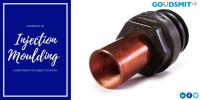 Add My Company
Add My Company
Sign In

What is injection moulding?
Injection Moulding is a manufacturing process for producing parts in large volume. It is most typically used in mass-production processes where the same part is being created thousands or even millions of times in succession.
Why use injection moulding?
The principal advantage of injection moulding is the ability mass produce. After the initial costs, the price per unit for injection moulded manufacturing is extremely low. The price also tends to drop as more parts are produced. Other advantages include:
1. Injection moulding has low waste rates compared to traditional manufacturing processes like CNC machining which cut away considerable percentages of an original plastic block or sheet. However, additive manufacturing processes like 3D printing have even lower waste rates.
2. Injection Moulding is very repeatable. Therefore, the second part produced is essentially going to be identical to the first one etc. This is a key characteristic when trying to produce brand consistency and part reliability in high volume production.
Downsides to injection moulding
Upfront costs tend to be high due to design, testing, and tooling requirements. When producing parts in high volumes, it’s important to get the design right from the outset. This may prove difficult, getting the design right includes:
- Designing and prototyping the part to specification.
- Initial prototype development is typically completed on a 3D printer, often in a different material than what the final part will be manufactured in.
- Designing an injection mould tool for initial production.
- Typically generating 300-1000 injection moulded prototypes in the production material requires the development of an injection mould tool.
- Refining any and all details in the injection mould tool prior to mass-production.
Negative aspects of injection moulding
1. Two of the major disadvantages to injection moulding are the high tooling costs and lead times. Before producing an injection moulded part, you must design and prototype a part, then design and prototype a mould tool that can produce replicas of the part in volume. To get the tool correct prior to mass production requires both time and money. It’s rare to prototype an injection moulding tool. However, in some circumstances it does happen, especially for parts that will be made in a multi-cavity tool.
2. Tools are typically made of steel or aluminium, so it can be difficult to make changes. To add plastic to the part, you can always make the tool cavity larger by cutting away steel or aluminium. However, to remove plastic you need to decrease the size of the tool cavity by adding aluminium or metal to it. This is extremely difficult and, in many cases, might mean needing to scrap the tool (or part of the tool) entirely and start over. In other cases, you might be able to weld metal into the cavity that is undesired.
3. Generally, large parts cannot be produced through injection moulding as a single piece. This is due to the size limitations of injection mould machines and the mould tools themselves. For example, consider a shopping trolley. Although the machinery exists to mould very large pieces, it’s very expensive. Therefore, objects that are larger than a typical injection moulding machine’s capability are most often created in multiple pieces.
4. Large undercuts require experienced design to avoid and can often add costs to the project.
Considerations for injection moulding
1. Financial Considerations
- Entry Cost: Preparing a part for injection moulding requires a large initial investment.
- Production Quantity
- Determine the number of parts to be produced, at which injection moulding becomes the most cost-effective method of manufacturing.
2. Design Considerations
- Part Design: Design the part from day one with injection moulding in mind.
- Tool Design: Design the mould tool to prevent defects during production.
3. Production Considerations
- Cycle Time: Minimise cycle time as much as possible. Using machines with hot runner technology will help as will well-thought-out tooling. Small changes can make a big difference and cutting a few seconds from your cycle time can translate into big savings when producing millions of parts.
- Assembly: Design your part to minimise assembly. Much of the reason injection moulding is done in southeast Asia is the cost of assembling simple parts during an injection moulding run. To the extent that you can design assembly out of the process you will save significant money on the cost of labour.
Goudsmit UK
Using our extensive scope of capabilities including 3D design support, automation, tooling solutions, and reverse engineering, Goudsmit UK help you eliminate design flaws prior to production.
Contact us today for more information at info@goudsmit.co.uk. Or to speak to a member of our team call us on +44 (0) 2890 271 001.
For more information on our injection moulding capabilities visit our webpage.
Follow us on LinkedIn, Twitter and Facebook for regular updates.
For more information on Everything You Need to Know About Injection Moulding talk to Goudsmit Magnetics (UK) Ltd
Enquire Now
List your company on FindTheNeedle.

